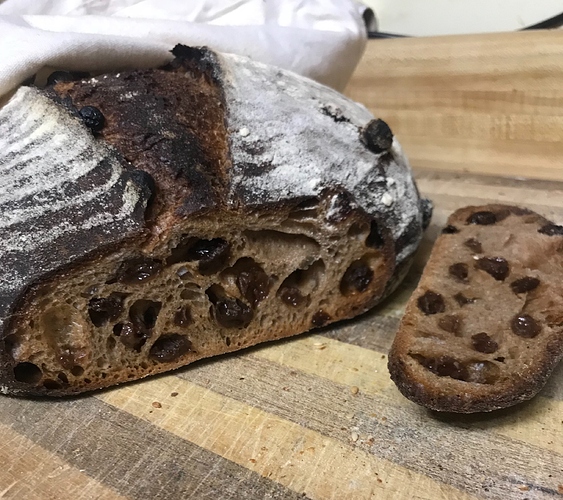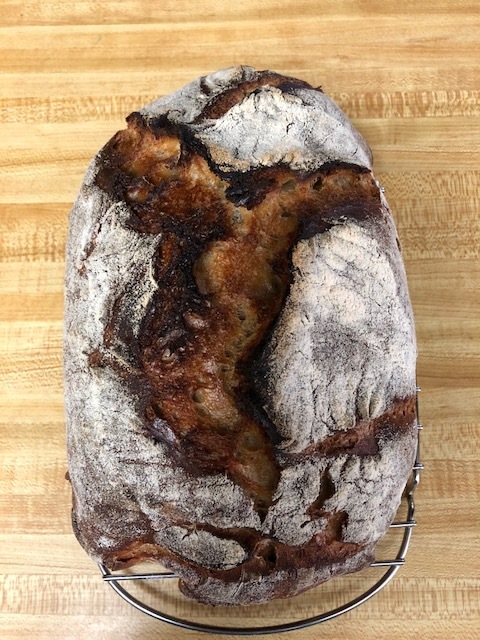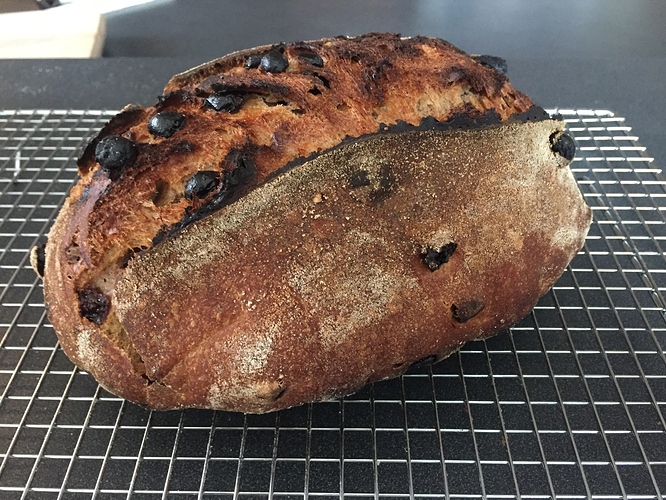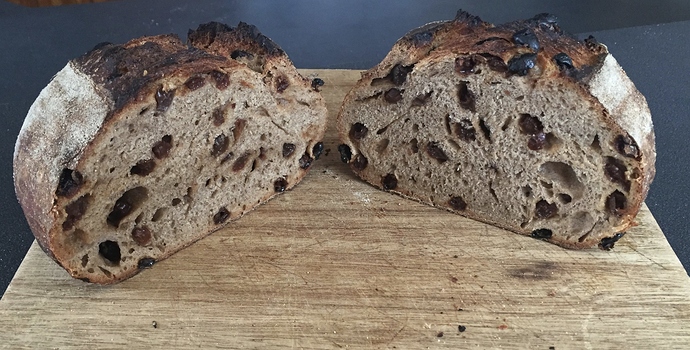Good morning! I’m new to sourdough baking and just mixed up the cinnamon raisin bread. The dough seems unusually wet. Is this normal?
I have made this recipe three times while we wer in Mexico (sea level) as we were in Manzanillo. I had to cut the Maple syrup in half and cut back on the water as well. The dough was still like a batter. I have done some stretch and folds adding flour each time and the dough was still not one that I could form it into a loaf. I dropped it in the clay baker. Turned out great and tasted wonderful. The flour in Manzanillo was quite different than at home, but I’ve made a loaf since back in Manitoba. Same batter like consistency when using recipe amounts. I’m adjusting the recipe for my use so it can be formed like normal bread and not poured into my pot. GREAT TASTE NO MATTER HOW I GET IT DONE.
Did anyone try with honey instead of maple syrup?
Baked for the first time today and its so easy - tastes amazing! Having read the group’s comments about the dough being very wet, I did 4 stretch/folds at 6 minute intervals on a heavily floured surface to give it a bit more structure. Given Philip’s experience, I HEAVILY floured my proofing basket and placed a parchment round on bottom of my Lodge pan to prevent sticking. Had no trouble at all: the dough was very manageable, it came out of the basket beautifully and didn’t stick after baking. I wonder if its my lack of altitude - I’m in northern Alberta (altitude just 645 feet).
The smell was so amazing that we couldn’t wait for it to cool before cutting in - which unfortunately resulted in a slightly squished loaf, but the taste was well worth it - we polished off half the loaf in minutes! Being a cinnamon fan, I tripled the cinnamon but the use of Sri Lankan “true” Cinnamon (vs Vietnamese Saigon-Cassia), prevented the spice from becoming sharp or overpowering.
My only problem was the bottom being overdone - bordering on burnt. I took it out after 10 minutes uncovered at 450 (vs 20 minutes) because the top was so dark. It could have been my Lodge pan but I don’t have this problem with plain Sourdough bread. Has anyone else experimented with different cooking times/temperatures? Already planning to mix up a second loaf later today!
I’m pretty much saying what the majority of people are saying here, that the measurements seem whacked out, at least for me based on using King Arthur whole wheat replacing red fife. It’s way too wet to work with. I probably added another cup of flour after overnight rise. And I’ve improvised on this recipe many times before I got my scale, just using the basic sourdough recipe, using my eyes and feel to adjust the addition of maple syrup. That was always a success and a hit with the family! But now that I have a scale and very carefully measured, it was a unmanageable frustratingly wet mass after proofing. I’m confident it will come out good cause it’s hard to not have a great tasting loaf with this one if you have the right consistency. However, I am returning to my basic no-knead sourdough recipe and improvise the portions.
I made this bread for the first time today, and found it to have very little rise. Since I used my starter for another recipe at the same time, I know that the starter was sufficiently active. I was hesitant to put in the TABLESPOON of cinnamon called for in the recipe, as I know that cinnamon can inhibit yeast activity, so I halved the cinnamon…but that is still a lot of cinnamon. I also reduced the baking temp to 425 degrees (from 450) because there’s a good bit of sweetener (plus raisins) in this bread. I used a scale to measure out ingredients, but had to add 3/4 cup or so flour, as the specified measurements gave something more like pancake batter than bread dough, and I kneaded in more flour before turning it into the baker or it would have been totally unmanageable. I made no other changes in the recipe, and I live at sea level. I baked in one of the long clay bakers from this site, had a good 4 inches of clearance from the bottom heating elements and still had burned bottom crust. All that being said, the rather dense super-moist loaf still tastes better than no bread at all on this first cool Monday in October on the Gulf Coast.
In general, my comments to myself for next time are: reduce cinnamon to a tsp. or less, add more flour from the start, reduce baking temp to 400 degrees and cross my fingers! If that doesn’t do it, I’ll supplement with a bit of instant yeast…no purist here, just a bread enthusiast.
I also was concerned about the dough sticking to the banneton. What I did was heavily flour the banneton AND the top of the shaped dough before flipping it in the basket. When I turned it out before baking I brushed the excess flour off with a brush. I also soaked the raisins in a splash of rum the night before. Turned out awesome
I have followed this recipe exactly and the dough is coming out very very wet, more like batter. I wonder if the ingredients are correct or should the dough be so runny? Thanks, Alina
Hi, Alina. Try reducing the water by about 35–45g. With the maple syrup, that decrease in water shouldn’t have any negative effect on the dough. It may be easier to handle.
I love baking this bread for family and friends. Recently though, I have had to modify this recipe to accommodate dietary restrictions for my husband’s health. This bread was one of his favorite ones I bake but he can no longer eat raisins, must have low sodium, and no more whole grains. SO, I’ve had to modify this recipe for him. I switched the bread flour from the select, which was more whole grain, to the high protein white bread flour. I don’t put in the salt. Though the salt is a plus in the taste, because of all the cinnamon, it isn’t really missed all that much. The biggest modification came in figuring out how much water to use! Recently I had a huge bread FAIL because I forgot to reduce the amount of water in the recipe to account for using white bread flour and NO raisins. Trust me, it wasn’t pretty, LOL! It was a soggy, wet pancake of a bread that ended up in the trash. Today’s bake came out AWESOME! Take a look at these pictures of my cooling bread!
It’s HUGE!! When I took the lid off the clay baker to finish baking it had filled the baker and was so nice and tall!
Now I’m writing down my water amount modifications on my recipe page because I definitely want to remember what actually worked! For this particular loaf, using all white bread flour, no raisins, no salt I have reduced the water to 325g from the original 400g. I still used the 150g of maple syrup and 100g of sourdough starter. I only eliminated the raisins and the salt.
I can’t wait to cut into this bread and see what the crumb looks like, but by all indications on it’s height, this should be a glorious loaf my husband will enjoy.
I want to make an autumn version of this, with pumpkin pie spice instead of cinnamon and dried cherries instead of raisins – both are easy substitutes. But I’d also like to add canned pumpkin. How can I do that? Would I need to decrease flour and/or water amounts? How much canned pumpkin would work well? Thanks!
I have not made exactly this recipe, but I do make an oatmeal pumpkin bread:
For 1 loaf:
120 grams pumpkin puree (1/2 can)
104 g water
1/2 T salt
2.5 T butter
1-2 T honey
28 g oats
50 g whole wheat
45 g rye
158 g white flour
248 g starter (100% hydration)
So, if you do the math, there is 228 g water and 405 g flour/grain to 120 g (1/2 can) of pumpkin (I’m including the starter at 124 & 124 in that calc).
The above recipe is a LOT lower hydration than the Sourdough Cinnamon Raisin recipe although extra comes from some pumpkin. Still, if it were me, I would reduce water … for 1 can pumpkin in the Sourdough Cinnamon Raisin Bread recipe, I’d leave the starter at 100 g and reduce overall water by 100 grams for a first try. I’d leave the flour amount as is 500 g total plus what is in the starter.
That’s my method for tinkering with recipes: look at ratios of something similar or something I know works for me and then adjust accordingly.
Ohh!!! meant to clarify also that I’m using pumpkin puree from fresh pie pumpkin, i.e. roasting pumpkin and pureeing it vs canned. I haven’t adjusted anything if I use canned instead, but it does seem to me that the canned pumpkin is thicker/less “watery”. All to say, if using canned maybe reduce water by 80 grams instead of 100 ???
@tracylovesbread, I definitely want to try an “autumn” version of this bread too because I love the recipe so much. It’s my “go-to” cinnamon raisin bread along with the modified one I make for my husband. Even though I REALLY want to add pumpkin (I only have canned pumpkin) I’m considering your suggestion of using pumpkin pie spice instead of the cinnamon. I think adding dried cranberries would be an awesome substitute for the raisins. Raisins would certainly work too but cranberries are so “autumn.”
Leah
After reading many of the comments, I made this bread with roughly 1/3 strong white flour and 2/3 whole wheat bread flour. Anticipating the wetter dough, I added an additional 1/2 of whole wheat flour. Room temp in my house is 68 degrees so I increased the starter to 150 grams. I covered and proofed the dough in my slightly warm oven (80degrees but cooled to room temp by the end of 8 hours). I checked it at 4 hours and it seemed to barely rise. At 8 hours it was roughly the same as the four hour check. I turned it out and folded it with a dusting of ww flour and put it in a round proofing basket with lots of flour to prevent sticking as the dough was still very soft. I proofed it overnight in the fridge. In the morning I preheated my oven to 465 with a baking sheet for water/steam. I turned the dough out on a cookie sheet, brushed off the excess flour, cut some slits in the top, placed it in the preheated oven, poured boiling water in the preheated baking sheet, and baked the bread for 40 minutes. I was sceptical that it would rise since there was very little visible rising the day before but it rose enough to produce a nice textured bread! Baking at 950 feet above sea level.
@roseflower, I’ve noticed when baking this particular recipe that after anywhere from an 8-12 hour initial ferment or rise in the bowl the dough barely looks like it’s risen at all. My personal theory is that because the dough is such a wet dough, the air bubbles in the starter simply aren’t trapped as much. However, every time I finish the process and actually bake a loaf, it comes out beautifully! It just might be the nature of this particular recipe/dough. By the way, I’m just about to toast up a slice of my sourdough cinnamon raisin to have for breakfast (as soon as I feed the puppy who’s asking for his morning meal, LOL).
Enjoy your bread!
Leah
I noticed that several people found this dough too wet. I calculated the hydration of the dough, taking into account both the flour and the water in the starter, 50 grams assuming a 100% percent hydrated starter, and the water in the maple syrup, about 32% according to the USDA food database or 48 grams, as about 83%.
If this is too hydration much for you to work with, I would suggest reducing the water to 382 grams for 80% hydration, or to 355 grams for 75% hydration.
I have not actually made this bread, yet, but when I do, I will probably reduce the hydration to no more than 78% (371 grams of water). I seldom work with dough in excess of 80% hydration without running into problems. I will probably use King Arthur Traditional Whole Wheat and King Arthur Bread Flour as I have had a lot of experience with them and specialty flours are hard to find in my area.
I just recalculated the hydration for this recipe because I noticed that I had, inadvertently left 40g of water our of the calculation I posted, yesterday. I found that the hydration is actually almost 91% rather than 83%. That is certainly very high for a dough with only one-third whole wheat flour, in my experience. I definitely will lower the hydration to about 78% by reducing the water by 69g when I make this loaf.
Baked this loaf this morning. Reduced hydration to 79.6% (440g water) and reduced raisins to 136g.
At 9:45 PM, yesterday, I shaped the dough into a batard, placed it into a rice floured linen liner and put it into the refrigerator for a retarded proof until 7:00 AM.
Baked in preheated (45 minutes) oval Breadtopia la cloche, covered @500F for 20 minutes, @450 for 10 minutes, then uncovered for 20 minutes @450. As bread was well colored, but only 174F internal temperature, I re-covered the la cloche and baked an additional 10 minutes. Final internal temperature was 202F.
 . Here’s my first try today with said WW Raisin (Cherry). Would I make a few adjustments next time? Probably.
. Here’s my first try today with said WW Raisin (Cherry). Would I make a few adjustments next time? Probably.
Still, our backyard birds and squirrels are out of luck today…Delicious. For me, it’s the chew of sourdough as much as the flavor. (Maybe I’ll make Jim our homemade Nutella for his Valentines Day Breakfast.) image|374x500







